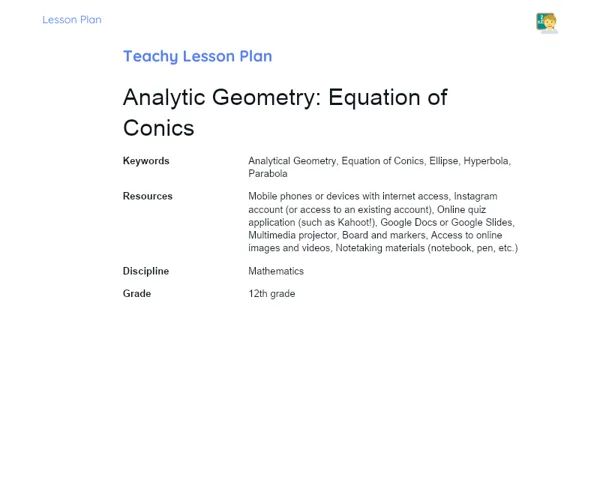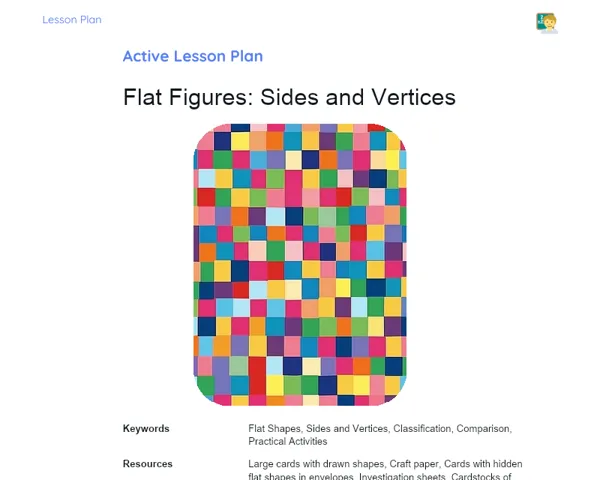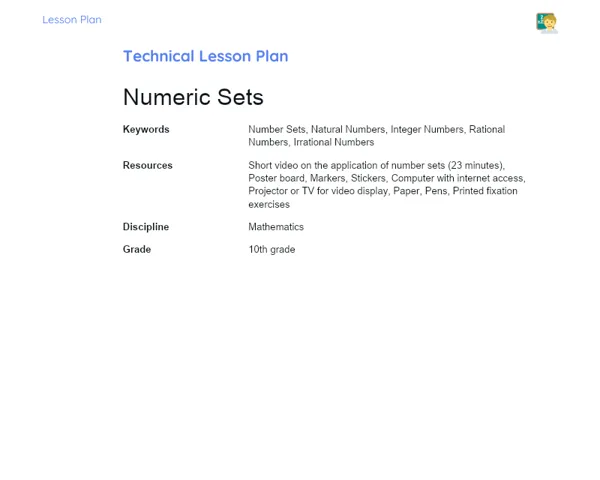Lesson Plan | Lesson Plan Iteratif Teachy | Spatial Geometry: Prism Volume
| Keywords | Spatial Geometry, Volume, Prisms, 3D Modelling, Tinkercad, Social Media, Gamification, Kahoot, Quizizz, Active Learning, Collaboration, Digital Tools, Engineering, Architecture, Design |
| Resources | Computers or Tablets, Internet Access, Accounts on Tinkercad or other 3D modelling tools, Smartphones with access to Instagram or TikTok, Video/Image editing apps (like Canva, InShot, etc.), Accounts on Kahoot! or Quizizz, Projector or TV for presentations, Papers and pens for notes |
| Codes | - |
| Grade | 11th grade |
| Discipline | Mathematics |
Goal
Duration: 10 to 15 minutes
The aim of this stage is to ensure that students grasp the importance of calculating the volume of prisms, and are prepared to use this understanding in real-world contexts, making use of digital and collaborative resources to enhance their learning.
Goal Utama:
1. Understand the formula for calculating the volume of prisms: the product of the base area and height.
2. Apply knowledge to practical, real-world problems.
3. Develop the skill to solve spatial geometry problems accurately.
Goal Sekunder:
- Utilize digital tools to visualise and manipulate prisms.
- Collaborate with peers to solve intricate problems.
Introduction
Duration: 10 to 15 minutes
The goal of this stage is to ensure that students appreciate the significance of calculating prism volumes and are ready to apply this knowledge in an engaging and contextual way, using digital collaborative tools to support their learning.
Warming Up
To kick off the lesson on the volume of prisms, explain to learners that spatial geometry has practical applications in fields like architecture, civil engineering, and design. Then, ask them to use their phones to dig up an interesting fact about prisms to share with the class. This quick activity will help make the topic relatable and illustrate its relevance in our everyday lives.
Initial Thoughts
1. What exactly is a prism and how does it differ from other geometric shapes?
2. Why is it crucial to calculate the volume of a prism?
3. Can you think of real-life situations where calculating the volume of prisms is essential?
4. How do the base area and height of a prism affect the volume calculation?
5. Have you come across prisms in everyday objects? What examples do you have?
Development
Duration: 70 to 80 minutes
This stage aims to provide learners with a relevant, hands-on learning experience using digital tools to tackle real-life problems while cultivating collaborative skills. The envisaged activities are designed to engage students in a fun and meaningful way, strengthening their understanding of prism volume calculations.
Activity Suggestions
Activity Recommendations
Activity 1 - 🏙️ Building the Prism City 🏗️
> Duration: 60 to 70 minutes
- Goal: Cultivate 3D modelling skills and apply geometric knowledge in a practical context.
- Deskripsi Activity: Groups will be tasked with creating a 'Prism City' using free 3D modelling software (like Tinkercad). Each group must design a city that incorporates at least five different types of prisms and calculate the volume of each. The presentation of the city should be imaginative, with the prisms symbolising buildings, bridges, towers, and more.
- Instructions:
-
Divide learners into groups of up to 5.
-
Every group should access Tinkercad (or similar software) and create an account if they don’t have one.
-
Demonstrate how to use the basic tools of the software to model prisms.
-
Groups should brainstorm and organise their city, deciding which prism types they will use.
-
Each group must create at least five different types of prisms and determine the volume for each.
-
Members should work together to design the 3D models, measuring their dimensions to calculate the volume.
-
Groups need to prepare a presentation explaining their design choices and showcasing the volume calculations.
-
Finally, each group will share their 'Prism City' with the class, highlighting the main challenges faced and lessons learned.
Activity 2 - 📸 Prism Influencer Challenge 📱
> Duration: 60 to 70 minutes
- Goal: Merge digital communication and math skills to create engaging educational content.
- Deskripsi Activity: Learners must create a series of posts on social media platforms (Instagram or TikTok) explaining how to compute the volume of various prisms and why it matters in everyday contexts. Each group will be responsible for producing educational yet eye-catching content using videos, images, and text.
- Instructions:
-
Split the class into groups of up to 5
-
Each group decides on a social media platform (Instagram or TikTok) for their posts.
-
Groups should map out a series of posts, including explanatory videos, images of their calculations, and daily life examples where knowing about prism volumes is relevant.
-
Encourage them to utilise video/image editing apps to create visually appealing and educational content.
-
Groups should record videos explaining how to calculate the volumes of various prisms and showcase real-world examples.
-
Promote creativity by suggesting the use of memes, popular songs, and interactive visuals.
-
Groups share their posts with the class, reflecting on how effectively they communicated mathematical concepts.
-
In the end, each group presents their content, noting the major hurdles they faced and what they learnt.
Activity 3 - 🎮 Prism Challenge - Math Gamification 🎲
> Duration: 60 to 70 minutes
- Goal: Reinforce understanding of prism volume calculations in a fun and competitive atmosphere, promoting teamwork.
- Deskripsi Activity: Groups will compete in an online quiz created on Kahoot! or Quizizz, where they will have to answer questions about calculating the volume of different prisms. The game will feature varying levels of difficulty, with questions that cover both practical and theoretical scenarios.
- Instructions:
-
Split learners into groups of up to 5.
-
Explain the rules of the game and how the competition will proceed.
-
Each group accesses the chosen platform (Kahoot! or Quizizz) and enters the game using a designated code.
-
The teacher leads the quiz, asking questions sequentially and managing the pace of play.
-
Questions will encompass different aspects of volume calculation for prisms, combining theoretical and practical problems.
-
Pause between questions to discuss the correct answers and clarify any uncertainties.
-
Groups work together to answer questions as quickly as possible, gathering points.
-
At the end of the game, the group with the highest score wins, with the teacher perhaps offering a small prize.
Feedback
Duration: 20 to 25 minutes
The aim of this stage is to cement learning through sharing experiences and reflections, fostering a collaborative environment. Additionally, the 360° feedback process helps students hone their communication and self-evaluation skills, which is vital for ongoing growth.
Group Discussion
Facilitate a group discussion where students share what they gained from the activities. Here’s a brief outline to get the discussion rolling: 'Let’s kick-off by sharing the experiences of each group while carrying out their projects. Each group should point out their major discoveries, any challenges encountered, and how they tackled them. This is a chance to learn from each other and reflect on areas for improvement in future tasks.'
Reflections
1. What were the main struggles faced while calculating the volume of prisms in your activities? 2. How did using digital tools (3D modelling, social media) enhance your learning about calculating prism volumes? 3. What was the most valuable lesson learnt while working in a group to solve the given problems?
Feedback 360º
Guide students through a 360° feedback session, where each student should receive insights from their group members. Emphasise that feedback should be constructive and considerate, focusing on strengths while also suggesting areas for improvement. Encourage them to use a simple format, like 'Strengths' and 'Areas for Growth', to structure their observations.
Conclusion
Duration: 10 to 15 minutes
The goal of this stage is to wrap up learning by linking it to real-world scenarios and underscoring the practical significance of the content studied. This conclusion reinforces the value of the knowledge gained and encourages students to apply it in their daily lives.
Summary
🌟 Fun Wrap-Up: Alright everyone! Today we delved into the fascinating realm of prisms, discovering how to compute their volumes. We had a blast working with 3D modelling software, crafting social media content, and participating in an exciting quiz! Now we’re experts in calculating prism volumes! 📏✨
World
🌍 In Today’s Context: This lesson connected mathematics to the digital lives of learners. We leveraged modern tools and creative approaches to understand traditional concepts. This showcases how education can be enjoyable and applicable in our technology-driven environments.
Applications
🏗️ Everyday Applications: Understanding how to calculate the volume of prisms is fundamental for various professions, such as architecture, civil engineering, and design. Moreover, these abilities come in handy for everyday tasks, like planning the layout of a space or estimating materials for a project.



